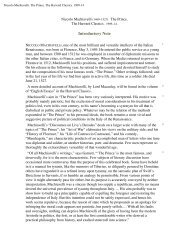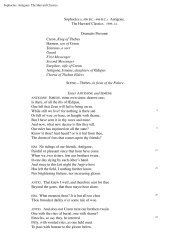Notre Dame de Paris - Bartleby.com
Notre Dame de Paris - Bartleby.com
Notre Dame de Paris - Bartleby.com
Create successful ePaper yourself
Turn your PDF publications into a flip-book with our unique Google optimized e-Paper software.
edifices in the grand style; the Place Royale shows us the <strong>Paris</strong> of Henri IV—brick fronts, stone copings,<br />
and slate roofs—tricolour houses; the Val-<strong>de</strong>-Grâce is the <strong>Paris</strong> of Louis XIII—low and broad in style,<br />
with basket-handle arches and something in<strong>de</strong>finably pot-bellied about its pillars and humpbacked about<br />
its domes. We see the <strong>Paris</strong> of Louis XIV in the Invali<strong>de</strong>s—stately, rich, gil<strong>de</strong>d, cold; the <strong>Paris</strong> of Louis<br />
XV at Saint-Sulpice—scrolls and love-knots and clouds, vermicelli and chicory leaves—all in stone; the<br />
<strong>Paris</strong> of Louis XVI in the Panthèon, a bad copy of Saint Peter’s at Rome (the building has settled rather<br />
crookedly, which has not ten<strong>de</strong>d to improve its lines); the <strong>Paris</strong> of the Republic at the School of<br />
Medicine—a spurious hash of Greek and Roman, with about as much relation to the Coliseum or the<br />
Panthèon as the constitution of the year III has to the laws of Minos—a style known in architecture as<br />
“the Messidor”; 44 the <strong>Paris</strong> of Napoleon in the Place Vendôme—a sublime i<strong>de</strong>a, a bronze column ma<strong>de</strong><br />
of cannons; the <strong>Paris</strong> of the Restoration at the Bourse—an abnormally white colonna<strong>de</strong> supporting an<br />
abnormally smooth frieze—it is perfectly square and cost twenty million francs.<br />
To each of these characteristic buildings there belongs, in virtue of a similarity of style, of form, and of<br />
disposition a certain number of houses scattered about the various districts easily recognised and<br />
assigned to their respective dates by the eye of the connoisseur. To the seeing eye, the spirit of a period<br />
and the features of a King are traceable even in the knocker of a door.<br />
The <strong>Paris</strong> of to-day has, therefore, no typical characteristic physiognomy. It is a collection of samples of<br />
several periods, of which the finest have disappeared. The capital is increasing in houses only, and what<br />
houses! At this rate, there will be a new <strong>Paris</strong> every fifty years. The historic significance, too, of its<br />
architecture is lessened day by day. The great edifices are be<strong>com</strong>ing fewer and fewer, are being<br />
swallowed up before our eyes by the flood of houses. Our fathers had a <strong>Paris</strong> of stone; our sons will have<br />
a <strong>Paris</strong> of stucco.<br />
As for the mo<strong>de</strong>rn structures of this new <strong>Paris</strong>, we would much prefer not to dilate upon them. Not that<br />
we fail to give them their due. The Sainte-Geneviève of M. Soufflot is certainly the finest tea-cake that<br />
ever was ma<strong>de</strong> of stone. The palace of the Lègion d’Honneur is also a most distinguished piece of<br />
confectionery. The dome of the Corn Market is a jockey-cap set on the top of a high lad<strong>de</strong>r. The towers<br />
of Saint-Sulpice are two great clarinets—a shape which is as good as any other—and the grinning zigzag<br />
of the telegraph agreeably breaks the monotony of their roofs. Saint-Roch possesses a door that can only<br />
be matched in magnificence by that of Saint Thomas Aquinas; also it owns a Calvary in alto-relievo<br />
down in a cellar, and a monstrance of gil<strong>de</strong>d wood—real marvels these, one must admit. The lantern<br />
tower in the maze at the Botanical Gar<strong>de</strong>ns is also vastly ingenious. As regards the Bourse, which is<br />
Greek as to its colonna<strong>de</strong>, Roman as to the round arches of its windows and doors, and Renaissance as to<br />
its broad, low, vaulted roof, it is indubitably in purest and most correct style; in proof of which we need<br />
only state that it is crowned by an attic storey such as was never seen in Athens—a beautiful straight line,<br />
gracefully intersected at intervals by chimney pots. And, admitting that it be a rule in architecture that a<br />
building should be so adapted to its purpose that that purpose should at once be discernible in the aspect<br />
of the edifice, no praise is too high for a structure which might, from its appearance, be indifferently a<br />
royal palace, a chamber of <strong>de</strong>puties, a town hall, a college, a riding-school, an aca<strong>de</strong>my, a warehouse, a<br />
court of justice, a museum, a barracks, a mausoleum, a temple, or a theatre—and all the time it is an<br />
Exchange. Again, a building should be appropriate to the climate. This one is obviously constructed for<br />
our cold and rainy skies. It has an almost flat roof, as they obtain in the East, so that in winter, when it<br />
snows, that roof has to be swept, and, of course, we all know that roofs are inten<strong>de</strong>d to be swept. And as<br />
regards the purpose of which we spoke just now, the building fulfils it to admiration; it is a Bourse in<br />
France as it would have been a Temple in Greece. It is true that the architect has been at great pains to










